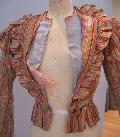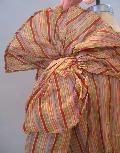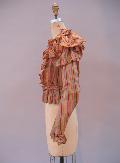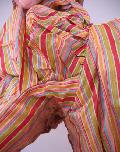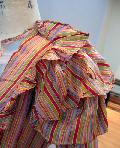Circa 1895-1897, this bodice is made of silk paper taffeta with woven stripes in green apple, bright red, yellow, pink, blue and white. The width ranges from pinstripes to 1/4 inch. The bodice is constructed on a foundation of bluish-gray printed cotton. The lining of the sleeve cuff, a pleated insert on the interior of the sleeve, and center front fillers are made of peach colored China silk.
Bodice
The foundation of the bodice closes up center front edge to edge with ten hooks and eyes. On the interior of center front, the loops of the hooks and eyes have been covered with a 5/8 inch facing. The facing edge closest to center front has been hand stitched and the other edge has been machine stitched. Bodices of this time period were mounted onto firm cotton linings with boned seams and would have fit close to the body.
A single waist dart on each side shapes the foundation of this bodice. It has a center back seam and curving side back seams. The interior seams and darts have been pinked. Bone casings were placed left of center front (7 3/4 inches long), the side seams (7 3/4 inches), side back (8 ½ inches), and center back (8 inches).
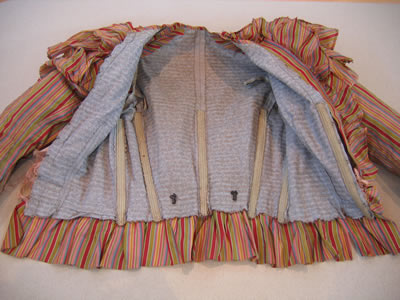
The armscyes were bound and hanger loops sewn in. Two hooks face down on either side of center back. These hooks served as an attachment point for the skirt. One of the dominant features of the bodice are the turned back portions of the striped fabric which form deep revers on either side of center front.
The front pieces of the bodice are cut with the straight grain running parallel to center front. To create the revers, the fabric has been folded back; starting at nothing at the waist and widening to 3 1/2 inches at the neck. A coarse linen gives the revers stiffness. It is hand basted to the underside near the folded edge with seam allowance extending into the body. The revers are edged with a gathered, bias ruffle. The frill starts as nothing at the neck intersection and grows to 2 1/4 inches at the point of the rever. A hand stitched, diagonal seam joins it with the ruffle continuing down the side of the revers. The ruffle tapers to 1 1/2 inch at the waist. The outside edge of the ruffle has been machine roll hemmed. The ruffle is stitched right sides together with the rever. On the back side, a doubled, 5/8 inch, straight grain piece of the striped fabric has been used as a facing to encase the raw edges of the rever and the ruffle. It also serves to hold the outer edge of the linen in place.
Bodices whose outer fabric had been turned back to create deep revers on either side of center front were very fashionable. The deep v-neckline and tapering revers reinforce the emphasis on a small waist. However, these turned back revers created a gap where the lining of the bodice and the edge to edge hook and eye closures were visible. To remedy this, a filler, or plastron, was used. This gathered piece of contrasting fabric usually extended from under the right side of the outer bodice fabric (under the revers) over center front and attached under the left side with hooks and eyes. This bodice however does not have any evidence of hooks and eyes on either side. In fact, basting stitches hold both sides of the peach silk in place under the revers. This, along with the gathering stitches at the neck, suggests that the plastron opened at center front. In Patterns of Fashion 2, written by Janet Arnold, there is a bodice dated circa 1895 with a similar style front. The front of the bodice has been tightly gathered into the neck and waist. The fullness of the fabric serves to disguise the hooks and eyes. There is no closure on the gathered piece.
Aside from the revers, the front pieces have no shaping. The side seams of both the front and back are on straight grain as is center back which has been cut on the fold. The back is cut all in one and the extra fullness of both the front and back has been gathered in at the waist and hand basted to the foundation. The front and back pieces are cut slightly longer than the foundation to allow for some blousing of the striped fabric. The bodice and foundation stop slightly below the waist and are pinked.
A straight grain, gathered ruffle extends below the waist and has a finished length of 3 1/4 inches. It is self-faced and the center front edges are bagged out. The ruffle is hand basted an inch up from the bottom edge of the bodice to the exterior with the seam allowance of the ruffle facing up. A bias, horizontally pleated belt covers the seam allowance of the ruffle. The waistband has five pleats, the narrowest being 1/4 inch. The same coarse linen that stiffens the revers serves as the base of the belt. Seam allowance at the top and bottom of the pleated fabric are turned over the linen band. The belt is tacked onto the bodice with a visible hand running stitch on the interior.
The outer bodice and the foundation are joined at the shoulder seam which has been left unfinished on the interior. The shoulder seams of the bodice are 4 inches long and slant towards the back approximately 1 1/2 inches from the natural shoulder point. The outer bodice and foundation are also partially joined at the neck. The neckline is rounded to closely follow the base of the neck. It has been hand finished with a 1/4 inch bias binding of the striped fabric. Also gathered into the bias binding at the neck is the filler portion which would have hidden the center front closure exposed by the revers. This plastron has completely deteriorated. A bit of the tightly gathered peach fabric remains at the neck and just above the waist on the exterior of the foundation. Large hand basting stitches still hold some of the turned under edge of the plastron in place under the revers.
Sleeves
Sleeve caps began to expand in the late 1880’s, eventually reaching enormous proportions. Sleeves of this style, referred to as leg-o-mutton, were a revival of sleeve styles from the 1830’s. Sleeves continued to expand throughout the 1890’s, but by the fall of 1895 their enormous size was deemed unfashionable. However, the fullness of the sleeve did not completely disappear. The largeness of the sleeve diminished into a poof that was set high on the arm. The remainder of the sleeve fit snugly to the wrist. Many times this fullness in the cap was accentuated by frills or epaulets. Though smaller in size than the enormous leg-o-mutton sleeves, these sleeves, coupled with epaulets, created a broad shouldered silhouette. Their broadness emphasized a small, tightly corseted waist.
The sleeves of this bodice reflect this mid to later period of the 1890’s. The moderate fullness is concentrated above the elbow in the upper sleeve. The under sleeve has no fullness. In Patterns of Fashion 2 Janet Arnold provides a period pattern from the August 1894 Le Moniteur de la Mode, The Lady’s Magazine which depicts an “Illustration(s) and diagram(s) of the new ‘gigot’ sleeve.” The new gigot (No. 4) is one of the handsomest, most stylish of sleeves which can be made. Full and draped above the elbow, yet tight below,… There is another method of making it (I think a better one), which the sleeve is in two portions-a very wide upper and an ordinary under sleeve… Another advantage of No. 2 is that the fullness of the elbow … is less extensive. The gathering consists of six or seven inches, seven at the utmost (according to the delicacy of the material). (Arnold, 13) This pattern and description coincide with the construction that is present in the sleeves of the bodice.
The original has a two-piece shaped sleeve. The striped fabric has been flat lined at the seams with the same cotton fabric used in the foundation bodice. The under sleeve (of both the cotton and silk) is a normal, tight fitting sleeve. The cotton portion of the upper sleeve is fitted normally and acts as the foundation to which the fullness of the striped silk is gathered. The cap of the silk upper sleeve is very full and tightly gathered into the armscye. This sleeve is also gathered in the seams of the sleeve 2 inches down from the armscye. Where these gathers end on the seams, a 1/2 inch tuck has made so the fullness of the puff extends up before it falls down. The upper sleeve also has two 1/2 inch pleats at the elbow. The interior seams of the sleeve have been hand overcast.
At the wrist is a square cuff, or fall, which is 1 1/2 inches wide. It is flat lined with cotton and lined with the peach silk. The square fall has been slashed in the center of one of the sides in order to apply it to the bottom of the sleeve. The fall is stitched to the sleeve 1 1/2 inches from the underarm seam around and ends 1 1/2 inches from the underarm seam. This leaves a 3 inch section of the underarm with no fall. The sleeve is finished with a facing of the striped silk. At the hem of the sleeve, where the fall joins the sleeve, a portion of the peach silk has been hand basted to create a frill. The silk is pleated into 1/4 inch accordion pleats and is 1 3/4 inches long. The bottom edge of this frill is finished with 1/2 inch wide, ivory cotton lace. The lace edge hangs out below the fall of the sleeve. At the armscye of the sleeve, a 6 inch bias ruffle which extends 4 inches in front of the shoulder seam and 1 1/2 inches below, is tightly gathered. It is cut on the bias and finished by a machine rolled hem.
| Lower Portion of Sleeve | Detail of Sleeve Fall | Detail of Ruffle |
 |
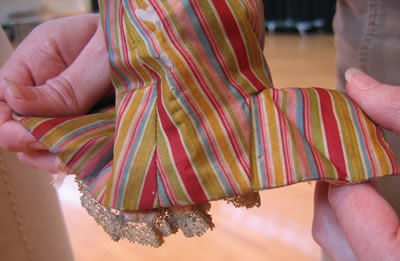 |
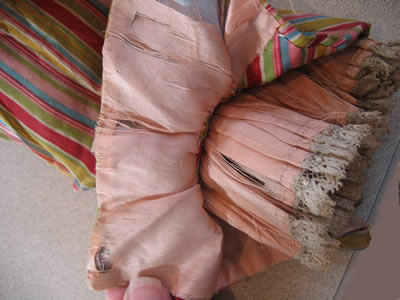 |
Damage
One important detail is missing from the original bodice; the collar. During the 1890s women’s necks were entirely hidden beneath high collars which reached to just below their chins and often contained boning. These collars closed at the side or in the back. Examination of the bodice yielded no clues to the presence of a collar or how it would have attached. There is no evidence of stitching or closures that held the collar to the bodice. It is most likely that it has been lost or re-fashioned over the years along with the matching skirt.
© Jade Bettin, 2006




